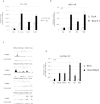NLS-tagging: an alternative strategy to tag nuclear proteins
- PMID: 25260593
- PMCID: PMC4245968
- DOI: 10.1093/nar/gku869
NLS-tagging: an alternative strategy to tag nuclear proteins
Abstract
The characterization of transcription factor complexes and their binding sites in the genome by affinity purification has yielded tremendous new insights into how genes are regulated. The affinity purification requires either the use of antibodies raised against the factor of interest itself or by high-affinity binding of a C- or N-terminally added tag sequence to the factor. Unfortunately, fusing extra amino acids to the termini of a factor can interfere with its biological function or the tag may be inaccessible inside the protein. Here, we describe an effective solution to that problem by integrating the 'tag' close to the nuclear localization sequence domain of the factor. We demonstrate the effectiveness of this approach with the transcription factors Fli-1 and Irf2bp2, which cannot be tagged at their extremities without loss of function. This resulted in the identification of novel proteins partners and a new hypothesis on the contribution of Fli-1 to hematopoiesis.
© The Author(s) 2014. Published by Oxford University Press on behalf of Nucleic Acids Research.
Figures






References
-
- Grosveld F., Rodriguez P., Meier N., Krpic S., Pourfarzad F., Papadopoulos P., Kolodziej K., Patrinos G.P., Hostert A., Strouboulis J. Isolation and characterization of hematopoietic transcription factor complexes by in vivo biotinylation tagging and mass spectrometry. Ann. N. Y. Acad. Sci. 2005;1054:55–67. - PubMed
-
- Pilon A.M., Ajay S.S., Kumar S.A., Steiner L.A., Cherukuri P.F., Wincovitch S., Anderson S.M., Center N.C.S., Mullikin J.C., Gallagher P.G., et al. Genome-wide ChIP-Seq reveals a dramatic shift in the binding of the transcription factor erythroid Kruppel-like factor during erythrocyte differentiation. Blood. 2011;118:e139–148. - PMC - PubMed
-
- Soler E., Andrieu-Soler C., Boer E., Bryne J.C., Thongjuea S., Rijkers E., Demmers J., Ijcken W., Grosveld F. A systems approach to analyze transcription factors in mammalian cells. Methods. 2011;53:151–162. - PubMed
Publication types
MeSH terms
Substances
LinkOut - more resources
Full Text Sources
Other Literature Sources
Molecular Biology Databases

